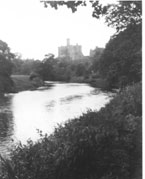
COQUET SOURCE

"The Roman Station at Chew Green, locally known as Makendon Camp, lies at the very source of the Coquet, on the northern boundary of the parish of Elsdon, close under the shadows of the lofty crest of Thirlmoor."
Upper Coquetdale. David Dippie Dixon. 1903
The source of the Coquet is almost on the Anglo-Scottish border near a former Roman camp called Chew Green. The Roman road called Dere Street ran close by. It is a remote and lonely landscape frequented mostly by walkers doing the Pennine Way walk or climbing the old drovers tracks in the Cheviot valley. But there are others. The Army Training Estate is an area of 60,000 acres in the heart of the Northumberland National Park which has been set aside by the Ministry of Defence for army training since 1911. The road through the valley from Alwinton to Makendon and beyond is fully open to the public only on certain days and then it is possible to continue on over the hills to Rochester and Otterburn on the A68 and A696 roads. The military presence carries on from the Roman military occupation (with a gap of 1600 years between), and the warlike activities of the Border Reivers whose lawless activities made the borders such a turbulent place in the 15th and 16th centuries.
For all that, the initial stretches of the Coquet are worth visiting, here you are in a land of empty rising hills, though often grazed by sheep, while small forests break up the expanses of moorland. The valley road provides access to farms and small settlements along the way and the river is never very wide between its source and Alwinton, though wide enough to require several bridges across its waters. It flows roughly east initially, then northeast, then south and east again to pass Alwinton, a small village at the foot of the Cheviot Hills.
Upper Coquetdale was always remote country, far from the comforts of the town and it knew harsh winters, though these have eased somewhat in recent years. People were accustomed to being 'snowed in' at some time during the winter months, but with road improvements and the advance of motorised transport this is not the problem it once was. The first bridges are purely functional, possessing no architectural features which might make them attractive to the eye, and reinforced concrete is the material of choice here. It is not until Linbriggs, scarcely a mile from Alwinton, and well down the valley that we reach the first bridge that has any pretensions to beauty and it is its arched structure that makes it stand out from previous bridges, though it, too, is of concrete.
- Constructed - not applicable
- Type - not applicable.
- Position: west of Chew Green, Northumberland.
- Grid Ref: NT 776 077

